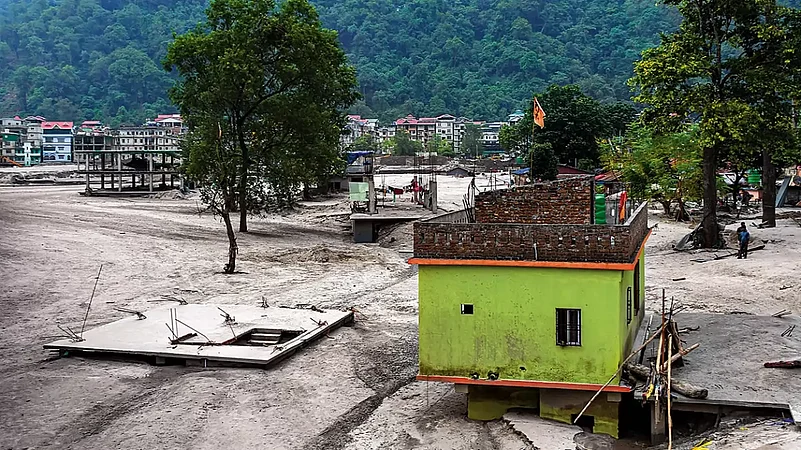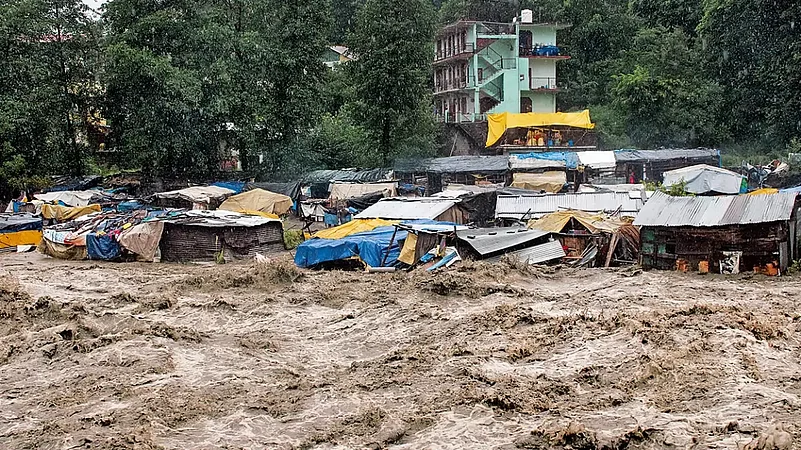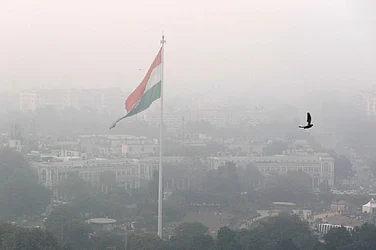In November, the Himalayan state of Uttarakhand drew global attention after a partial collapse of the under-construction Silkyara-Barkot tunnel in Uttarkashi district entrapped 41 workers. The gruelling rescue operation to save the men took 17 days as well as international and local technology and expertise. Such partial collapses due to landslides while tunneling in the Himalayan region happen almost regularly and are often ignored. This very tunnel had caved in many times in the past.
The Silkyara-Barkot tunnel is part of Prime Minister Narendra Modi’s pet initiative: the Char Dham project that aims to connect four major Hindu pilgrimage sites in the Himalayas—Kedarnath, Badrinath, Yamunotri and Gangotri–with all-weather, two-lane highways covering 889 km. The Rs 12,000 crore project has been controversial right from the start, with environmentalists expressing deep concerns over its ecological impact. However, the government won the battle in the Supreme Court in December 2021 after it argued that the project assumed “strategic importance for national security” following China’s enactment of a new law to strengthen its land border protection.
The questions of national security, energy security and water security have frequently featured in India’s arguments for building mega infrastructure in the Himalayas—from Ladakh and Kashmir in the north to Arunachal Pradesh in the northeast. One of the government’s prime arguments for building the country’s biggest dam on the Siang River in Arunachal Pradesh is to counter the dam China is building on the other side of the border.

While security almost always takes precedence over ecological or livelihood concerns, such mega projects in the Himalayan region are likely to face more questions in the coming days, as a flurry of reports published around the ongoing 28th edition of the global climate change conference, COP28, warns of increased frequency and intensity of natural disasters in the Himalayan region due to various aspects of climatic changes. “Mountainous regions with high population densities such as the Himalayas are particularly vulnerable” to climate change, says a paper titled ‘10 New Insights in Climate Science’ launched on December 3 at the COP28 venue.
The increased risks of flooding from glacial melt gets compounded by the thawing of permafrost, the report said, adding that it “causes cascading hazards such as landslides and debris flows.” Permafrost is perennially frozen ground, or soil on or below the earth’s surface that remains frozen for at least two years. Thawing of permafrost can destabilise mountain slopes.
“As glaciers melt, risks of catastrophic events—landslides, sudden ice shears, and in some cases, glacial lake outburst floods–will rise, affecting entire communities,” says the State of Cryosphere Report, published in November 2023. It also points out that new research suggests that glaciers can now produce floods even at the highest elevations, which were previously stabilised by snowfall and a cooler atmosphere.
The changing monsoon pattern is making the situation even more complicated. The Global Tipping Points Report, published on December 6, says that “it is indisputable that High Mountain Asia [which includes the Indian Himalayan region] will become wetter in the long-term climate projection.” Excessive rain is one of the major triggers of landslides and flash floods.
The monsoon is, indeed, emerging as a deadly season in the Himalayas. In Uttarakhand’s neighbouring state, Himachal Pradesh, 87 incidents of landslides, 16 flash floods, and 7 events of cloudbursts claimed 71 lives and destroyed property, livestock, and public infrastructure worth a few hundred crores in the 2021 monsoon. In 2022, there were 94 incidents of major landslides, 75 flash floods, and 14 cloudbursts, killing 39 people. In 2023, between June 24 and September 13, 165 landslides and 72 incidents of flash floods killed 145 people, according to the annual memorandum of loss and damage report published by the state’s disaster management authority.
A Contested Idea
Building large infrastructure in the Himalayas was always fraught with difficulties and danger as well as controversy. While the Himalayas being a young, folded mountain, is inherently fragile, it also has one of the densest populations among all mountainous regions of the world. The population growth led to rapid, unbridled urbanisation.
Over the past few years, a visible increase in the incidence of landslides, land subsidence and extreme weather events has strengthened the voices against the current growth-centric development trajectory, which Tikender Singh Panwar, former deputy mayor of the Himalayan town of Shimla, recently described as “utilitarianism”–where immediate profit triumphs over sustainability.
India is poised to execute major infrastructure projects–from the Char Dham project to railway connectivity in the eastern Indian Himalayan state of Sikkim and a series of large hydroelectric dams in all the Himalayan states. These projects would require hundreds of kilometres of tunneling through a geologically fragile landscape. And besides, aggressive promotion of tourism is leading to the construction of more tourist-centric infrastructure, often flouting building norms and regulations. While currently, summer makes up the main tourist season, the completion of the Char Dham project would likely draw more tourists in the monsoon months as well.
According to Aditi Mukherji, one of the authors of the ‘10 New Insights’ report, the new findings reiterate from the scientific perspective what is being repeatedly warned about—the global warming-induced melting of glaciers is a risk that India cannot afford to ignore. “Under the current scenario, the haphazard urbanisation and development with heavy infrastructure need to be reconsidered,” says Mukherji. “These are increasing the risks we already have from climate change.”
She endorses the need for development in the Himalayan region when it comes to basic infrastructure like schools, hospitals and local roads, which benefit the local population. But haphazard urbanisation and major infrastructure like highways and large dams, which are not directly necessary for the local people, should be avoided. It is important to note that while tourism benefits the local population, tourism flourished even without highways.
“Just recently we saw how a glacial lake outburst flood breached a hydropower dam in Sikkim and the tunnel collapse in the Uttar Kashi, besides mishaps in other Himalayan regions. All these show that the Himalayan region needs a sustainable development model, including a sustainable tourism model,” says Mukherji, director of the Climate Change Adaptation and Mitigation Impact Action Platform of the CGIAR (Consultative Group on International Agricultural Research), a global network.
Development for Whom?
The Himalayas are not the only ecologically sensitive region where the development model is being questioned. In 2022, the Delhi-based think-tank, Centre for Financial Accountability, noted in a report that between July 2014 and April 2020, the National Board for Wild Life (NBWL) approved 270 projects in and around biodiversity hotspots and national parks in different parts of India.
“Such a rate of approval, along with dilution of environmental laws, raises further concerns,” the report said, adding that the NBWL’s role had reduced to merely that of a “clearance house” for projects “under the pressure of economic growth.” Most of the infrastructure and developmental projects eventually get a go-ahead, even though it may come at the cost of irreversible destruction of precious flora and fauna in biodiversity hotspots, the report noted.
Earlier this year, the Union government amended the Forest Conservation Act in such a way that it would enable easier erasure of critical wildlife corridors outside Protected Areas, allow felling of unrecorded forests, and increase infrastructure like rail lines, roads, and roadside amenities in forested areas.
The new law exempts “strategic linear projects of national importance and concerning national security,” from seeking necessary clearances for felling forests within 100 km of the international border, which effectively means the entire Himalayan region.
Similarly, at a time when small and marginal fisher people along India’s coastal belt are already suffering from lower yields due to ocean surface warming and increased salinity, the Coastal Aquaculture Amendment Act 2023 decriminalised violations by shrimp aquaculture farms, which are predominantly owned by the moneyed class.
The new provisions allow regularisation of past violations even though shrimp aquaculture farms have frequently been blamed for increasing ground and surface water salinity, seawater pollution and usurping common land. They have been repeatedly hauled up by green tribunals. But the government-backed shrimp aquaculture because it is one of India’s major foreign exchange-earners.
In the Himalayas, mega hydro projects—which many scientific reports have warned are at great risk from glacial lake outburst floods and cloudbursts—are shown as essential for India’s energy transition away from coal as well as a necessary means for state governments to fill their coffers. However, the question of the development model becomes all the more critical in the context of the Himalayas because the threats are more direct and immediate today.
A research paper published in the journal, Nature, in June 2023 says that the Himalayas exhibited “a higher future risk of more frequent rainfall extremes,” which can have devastating impacts. “Unlike snowfall, rainfall triggers runoff more rapidly, leading to a higher risk of flooding, landslide hazards, and soil erosion,” it points out while highlighting that rainfall is considered to be the main driver of landslides.
A 2015 paper by Monique Fort, Professor Emeritus of Geomorphology and Environmental Sciences at Paris Diderot University, says that the thawing of Himalayan permafrost means this non-renewable water resource would be depleted and no longer available for the population living in these areas, “all the more as growing tourism activities are increasing the demand for water consumption that may conflict with irrigated agricultural uses down the valley.”
“Building infrastructure in the Himalayas needs utmost care. We need to be triply sure about what we are doing,” says Anjal Prakash, clinical associate professor (research) and research director at the Bharti Institute of Public Policy, Indian School of Business. He points out that India has a few practical concerns when it comes to development in the Himalayas. The security challenge coming from China’s rapid construction of infrastructure along the border necessitates India having its own infrastructure. The densely populated region has its own developmental needs. It is also home to centuries-old temples that draw pilgrims from around the country and internationally.
According to him, over the past couple of decades, the rise of the Indian economy has resulted in the emergence of a neo-middle class which is also spiritually inclined. Projects like Char Dham can lead to increased tourism and expand local residents’ income opportunities. Many of them rely on the earnings from the three months of the tourist season for sustenance for the whole year.
Prakash, however, is concerned that manipulation during the planning and implementation process leaves most projects technically defective. “The entire ‘rent-seeking process’ involving such projects must be eradicated. Due to rent-seeking even well-planned projects end up with poor implementation,” says Prakash, who was the lead author of the chapter on high mountains in the Intergovernmental Panel on Climate Change (IPCC)’s Sixth Assessment Report (AR6).
Rent-seeking refers to the practice of manipulating public policy or economic conditions as a strategy for increasing profits. Prakash alleges that every political entity favours big-ticket projects because the funds become a source of income to these entities.
“For building major infrastructure in the Himalayas, there has to be a strong scientific body to oversee these projects and minimise the leakage of funds as well as the risks,” he suggests, adding that the planning has to happen at a regional scale rather than at the state level. He argues that the local population must be engaged right from the planning stage because they know where the resources are and where the risks lay.
Himanshu Thakkar, coordinator of South Asia Network on Dams, Rivers and People (SANDRP), an environmental and human rights advocacy group, says that the key to infrastructural development projects in the Himalayan region is “democratic and informed decisions.” He points out that since climate change has worsened the inherent vulnerabilities of the Himalayan region, any major development activity needs to take the entire scenario into account. “Developmental projects must be based on democratic and informed decisions. Local people must be involved in the decision-making. There must be an honest, credible, and independent social, environmental, and disaster impact assessment. If local people are involved, they would ensure projects that hurt them are rejected.”
For development, the government needs to begin at the smaller, local level before making larger interventions and big projects should be considered only when localised options are exhausted. Thakkar also emphasises the need to adopt more nature-based solutions.
He emphasises that the new scenario necessitates that, particularly in the Himalayas, there must be a disaster impact assessment. This should address the probable impacts of projects on the disaster potential of the location, taking into account the inherent vulnerabilities, climatic changes, existing infrastructure, and other planned infrastructure. “There should also be a credible monitoring system for compliance, without which any impact assessment becomes useless. This kind of environmental governance has to be put in place but is entirely missing currently,” he adds.
At the COP28 venue, during an India-organised side-event on ‘Climate Resilient Development in Indian Himalayan Region,’ speakers pointed out that climate change’s impact on the Himalayas include those “on account of natural causes…resulting from anthropogenic emissions and developmental pathways.” India’s National Mission for Sustaining the Himalayan Ecosystem (NMSHE) was also highlighted. Whether such initiatives will eventually result in a significant change in the development model remains to be seen.


























